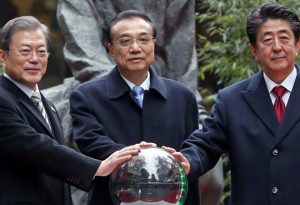 While I have suggested earlier that I don’t think an initial focus on building regional or multilateral institutions is necessarily the best first step in global governance and possibly a means to ‘tone down’ geopolitical competition rhetoric and action, I am now about to contradict myself and this position. For, in the end, there are some obvious regional and international institutions that could encourage collaborative action and push global governance collaboration. And, in fact, I have in mind an obvious one that has – as a current Chinese slang term might well describe it – ‘tang ping’ 躺平 – or ‘lying flat’. It is the Trilateral Summit.
While I have suggested earlier that I don’t think an initial focus on building regional or multilateral institutions is necessarily the best first step in global governance and possibly a means to ‘tone down’ geopolitical competition rhetoric and action, I am now about to contradict myself and this position. For, in the end, there are some obvious regional and international institutions that could encourage collaborative action and push global governance collaboration. And, in fact, I have in mind an obvious one that has – as a current Chinese slang term might well describe it – ‘tang ping’ 躺平 – or ‘lying flat’. It is the Trilateral Summit.
Trilateral Summit, you say. Well, yes, actually. The Trilateral Summit is, periodically, a Summit of the ‘key’ East Asia leaders – South Korea, Japan and most meaningfully, China. A little history here. The Trilateral Summit was first proposed by South Korea in 2004. At that time the three powers met for a separate session at the ASEAN gathering, described as ASEAN plus three. In 2007, at the eighth meeting of the ASEAN plus Three, the leaders agreed to initiate a separate Trilateral Summit. And, in December 2008, the first separate summit was hosted by Japan at Fukuoka. At its initiation the three powers saw the Summit focusing on: closer trilateral relations, the regional economy and disaster relief. One of the regional security issues that has been in front of leaders repeatedly has been the nuclear weapons program of the Democratic Republic of Korea, the DPRK. In the 2018 summit the FT described the leaders’ view of the DPRK nuclear weapons program: “the three leaders agreed to co-operate over North Korea and called for Pyongyang to give up its nuclear weapons completely.” While that agreement may no longer hold, it shows the value of this Summit.
The Summit is not quite a leaders’ gathering. While South Korea is often represented by its President and Japan by its Prime Minister, China has generally been led by its premier, not the President.
